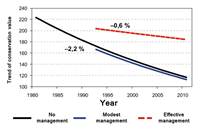
Monitoring is essential to determine if Important Bird Areas (IBAs) are being adequately managed. A recent analysis of IBA monitoring data by BirdLife Finland has shown that insufficient funding has caused a significant deterioration in the conservation status of the country’s protected area network. The report concludes that greater investment is urgently required in order to safeguard Finland’s natural heritage.

Important Bird Areas (IBAs) are widely recognised as critical places for the conservation of both birds and other biodiversity. According to the UN Millennium Development Goals Report, safeguarding the world’s IBAs would make a significant contribution to meeting the Convention on Biological Diversity’s targets on protected areas (UN 2010). In Europe, the IBA inventory has informed the designation of Special Protection Areas (SPAs), which together with Special Areas of Conservation (SACs), form a network of sites that provide legal protection to Europe’s most precious habitats.
Simply identifying priority areas for conservation however, is not enough. It is also necessary to ensure that sites are well managed. Across the BirdLife Partnership, IBA monitoring frameworks are in place to help assess the effectiveness of conservation measures and to provide an early warning of problems. A recent report from Finland, for example, used IBA monitoring data to reveal a worrying decline in the conservation status of the country’s SPA network. Using a scoring method—which assigns more weight to bird species of conservation concern (see Asanti et al. 2003)—the report found that the ‘Avian Community Wealth Index’ at Finnish SPAs had decreased since the 1960s; by 1.9 % per year in wetlands and 1.6 % per year across the archipelago. A slower, and statistically non-significant, decline was found for mires and forests in the north of the country (no data was available for the south) (Figure 1).The report makes clear that such declines can be reversed if appropriate resources are made available to conservation. It found that effective management, especially through large-scale restoration projects, had a very strong positive effect according to the Avian Community Wealth Index—on average a 50 % increase of Index value at the site level. Without exceptions, these successful ‘large projects’ had been funded by the EU LIFE-fund. At the network level, however, LIFE-funded management has not prevented overall deterioration, as there are four times too few management projects compared with real needs (Figure 2).

Unfortunately, the level and scale of management intervention has been insufficient to prevent the decline in conservation status of the country’s SPA network as a whole. Around 50% of Finnish IBAs still lack a management plan. Where management plans do exist, they are often deficient in key information and have no, or inadequate, budgets. The report conservatively estimates that, in order to stem the decline, a minimum annual sum of €11.1 million (€8.4 million for restoration, €1.7 million for management and €1 million for monitoring) or €40 per ha per year across the Finnish SPA network is needed. Current funding falls well short of this amount and the report concludes that, without the necessary investment, Finland could risk losing some of its most important wildlife sites forever.
Related Case Studies in other sections
References
Compiled: 2011 Copyright: 2011
Recommended Citation:
BirdLife International (2011)
IBA monitoring can identify deficiencies in national biodiversity policy.
Downloaded from https://datazone.birdlife.org/iba-monitoring-can-identify-deficiencies-in-national-biodiversity-policy on 22/12/2024